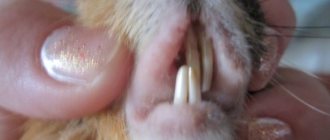There comes a time in any family when a small child grows up enough to ask his parents for a furry pet. Who could it be? Of course, the best option is a cat or a dog, but these animals are quite large, they take up a lot of space, require special care, and besides, the dog needs to be walked, and there are often allergies to cat fur.
Therefore, mom and dad most often make a choice in favor of a small creature, which the child, ideally, should take care of himself. But don’t delude yourself, in most families the young naturalist loses interest in the pet after two weeks - he can still play and feed, but one of the parents will have to clean the cage. So you need to choose a new family member in such a way that he does not arouse antipathy in anyone in the house.
Rabbits are very cute creatures. But it’s best to admire them somewhere on a walk, watching other people’s pets. Caring for these animals at home is not the easiest task. They are very gentle, they get sick easily, and besides, leaving the rabbit alone with the baby can be dangerous - both for the child, because the rabbit can bite painfully, and for the baby, for whom a fall from a child’s height can be fatal.
Ferrets and chinchillas are not cheap, and they require constant care and control. This is, rather, a pet for an adult who wants to please himself by communicating with such an unusual and charming creature.
Therefore, most often the choice is between a hamster, guinea pig or decorative rat. Communication with these animals gave me and my children personally a lot of positive emotions, although, without a doubt, each of them had their own pros and cons.
The hamster is a perpetual motion machine. He rushes from corner to corner, spins on a wheel, chews something all the time and rams it into his house - reserves “for a rainy day” must be systematically picked out and thrown away, otherwise there will simply be no room left for the rodent itself, and besides, fresh plant food it will simply rot. During the day, a fluffy little one can get a good night's sleep, and then at night a “disco” will begin in his cage - the endless furious rustling will soon drive a person with a light sleeper into psychosis.
Dungan hamsters are very cute, they are very tiny, a pair can easily fit on a child’s palm. But they are so gentle that you can only keep them in the same house with a child if he is already old enough and also incredibly responsible. And also, if possible, not too sensitive - “Dungans” die very often from a variety of reasons, in general, instead of joy, you can cause psychological trauma to the baby.
Guinea pigs are excellent companions for children. They are quite easy to tame, know their name, recognize their owner and greet him with a joyful squeak. They can jump up and down with excitement, which looks very touching. On the other hand, pigs do not have a choleric temperament like hamsters. This animal can be held on your lap, stroking and scratching - the pig will be completely happy. You can even walk with him; some owners buy special harnesses for this.
In general, a lot of positive things. One minus is that guinea pigs see the meaning of life in eating. At night, such a pet will most likely sleep. But as soon as someone in the family gets up to go to the toilet or simply wakes up first by the alarm clock, a forced wake-up is guaranteed for everyone else - upon hearing a stir in the apartment, the pig will immediately throw a tantrum about “it’s already morning, but I haven’t been fed”! The voice of this little creature is surprisingly loud and shrill.
I love decorative rats! Moreover, this is not love at first sight. Initially, they seemed to me like some kind of mistake of nature, vile tailed parodies of an ordinary gray rat, only with incomprehensible colors and the cheeky behavior of an intrusive neighbor. It took time for my opinion to change. Gradually, the understanding came that these small rodents are the most intelligent, trusting, affectionate and loving pets. In my opinion, in their affection for their owner, they can easily compete with dogs.
A cage was bought for the rat in which he was supposed to live, but the rodent turned out to be so sociable that he openly suffered in captivity. Then they started leaving the door open. The little rat had the opportunity to walk wherever he wanted and return to his house at his own request. There he slept, but sometimes he came into bed with the mistress and lay down next to her on the pillow - she assured in all seriousness that “The Rat had a nightmare” and he quietly complained in her ear. However, the rest of the time she was the most cheerful creature in the world, a full-fledged member of the family with her own character and bright charisma. When he died, the owner was completely inconsolable and sad for several years.
Best regards, Olga
Guinea pig and hamster are active, interesting and inquisitive furry animals that can bring joy and fun to small children. The first representatives of land animals are well suited for children from 3 years old, the second ones will become good friends for older ages. Which is better: a hamster or a guinea pig for a child? The material below will help you decide which rodent to get and make the right choice.
Pigs are easy to tame and do not require much care. With good care from the owner, the animal can live on average 5 years.
The period of activity in guinea pigs occurs during the day, decreasing in the evening. Unlike hamsters, they will sleep peacefully at night without disturbing the owner with their vital activities.
Character and training
Guinea pigs are distinguished by their friendliness, sociability, and calm nature. They can easily live next to cats and dogs, spending time in the same company without quarrels or discontent. They love to be pampered in the hands of their owner, to whom they feel great affection, exposing their fur coat for scratching. Noticing the presence of the owner, these animals begin to whistle loudly, expressing their good feelings and joy.
Pigs are completely devoid of aggression: they will never attack or even defend themselves, preferring to quietly retreat. If desired, the animals can be trained to perform a variety of tricks, since they train easily and successfully, which attracts the attention of children. A trained pig can follow its owner everywhere, stand on its hind legs or roll a small ball with its muzzle. When answering the question of which rodent is smarter, the advantage remains with the pig.
Care
A 6-year-old child can take care of the animal every day, but if you get an animal for a preschooler, an adult will need to take care of the creature. You will also have to monitor the baby so that, out of ignorance, he does not harm the pet, otherwise the injured pig may lose confidence in the owner.
Cell
A guinea pig needs a spacious cage in which it can lead an active lifestyle, moving freely inside the apartment. The condition is mandatory, since inactivity will lead to obesity and will not allow the animal’s legs to become strong.
The cage is located in a quiet place, protected from drafts and coolness, so that the pig does not catch a cold. There should be no wires nearby, since the nature of the rodent will certainly manifest itself in the ability to chew through hard objects. It is important to provide the cage with a special house where the pig can sleep or hide.
Essential plaid accessories
It is better to use regular sawdust as bedding, because pigs are big fans of burrowing, and the material should be harmless. You need to clean the cage periodically, as the sawdust will smell unpleasant. It is necessary that the cage has a drinking bowl with clean water and a feeder filled with food, fresh grass or hay. To help your pig grind down its teeth and claws, offer it a mineral stone or a hard piece of tree bark.
A running wheel should become a mandatory attribute of the cage, giving way to a mirror and ladders. Every day, the guinea pig must be let out for walks around the house, remembering to keep an eye on the animal, as it can end up in a hard-to-reach place and get stuck.
Nutrition
Guinea pigs are not picky eaters. They enjoy eating a variety of grains, herbs, vegetables and fruits. For herbs, they prefer lettuce leaves, parsley and dill, fresh dandelion leaves and spinach. Among fruits and vegetables, they can be fed fresh cucumbers, sweet peppers and carrots, apples, peaches and strawberries. Unlike hamsters, pigs cannot be fed meat, potatoes and cheese.
A distinctive feature of a pig is that it eats its own feces, which contains a vitamin that is beneficial for its body. If an animal begins to eat uncleaned excrement in a timely manner, a very young child can follow the animal’s lead, planning to independently evaluate the pig’s “delicacy.”
Pros of a guinea pig
About the benefits of a guinea pig:
- they are easy to care for;
- you can do training;
- complete absence of aggression;
- they love to be held;
- get along with other pets.
Another compelling argument for getting pigs is the opportunity to buy a hairless animal of the “Skinny” breed if the child is allergic to wool. When choosing a guinea pig as a pet, you need to remember to regularly clean the cage to avoid unpleasant odors in the house.
Ideal pet – hamster, pig or rat?
There comes a time in any family when a small child grows up enough to ask his parents for a furry pet. Who could it be? Of course, the best option is a cat or a dog, but these animals are quite large, they take up a lot of space, require special care, and besides, the dog needs to be walked, and there are often allergies to cat fur.
Therefore, mom and dad most often make a choice in favor of a small creature, which the child, ideally, should take care of himself. But don’t delude yourself, in most families the young naturalist loses interest in the pet after two weeks - he can still play and feed, but one of the parents will have to clean the cage. So you need to choose a new family member in such a way that he does not arouse antipathy in anyone in the house.
Rabbits are very cute creatures. But it’s best to admire them somewhere on a walk, watching other people’s pets. Caring for these animals at home is not the easiest task. They are very gentle, they get sick easily, and besides, leaving the rabbit alone with the baby can be dangerous - both for the child, because the rabbit can bite painfully, and for the baby, for whom a fall from a child’s height can be fatal.
Ferrets and chinchillas are not cheap, and they require constant care and control. This is, rather, a pet for an adult who wants to please himself by communicating with such an unusual and charming creature.
Therefore, most often the choice is between a hamster, guinea pig or decorative rat. Communication with these animals gave me and my children personally a lot of positive emotions, although, without a doubt, each of them had their own pros and cons.
Dungan hamsters are very cute, they are very tiny, a pair can easily fit on a child’s palm. But they are so gentle that you can only keep them in the same house with a child if he is already old enough and also incredibly responsible. And also, if possible, not too sensitive - “Dungans” die very often from a variety of reasons, in general, instead of joy, you can cause psychological trauma to the baby.
Guinea pigs are excellent companions for children. They are quite easy to tame, know their name, recognize their owner and greet him with a joyful squeak. They can jump up and down with excitement, which looks very touching. On the other hand, pigs do not have a choleric temperament like hamsters. This animal can be held on your lap, stroking and scratching - the pig will be completely happy. You can even walk with him; some owners buy special harnesses for this.
In general, a lot of positive things. One minus is that guinea pigs see the meaning of life in eating. At night, such a pet will most likely sleep. But as soon as someone in the family gets up to go to the toilet or simply wakes up first by the alarm clock, a forced wake-up is guaranteed for everyone else - upon hearing a stir in the apartment, the pig will immediately throw a tantrum about “it’s already morning, but I haven’t been fed”! The voice of this little creature is surprisingly loud and shrill.
I love decorative rats! Moreover, this is not love at first sight. Initially, they seemed to me like some kind of mistake of nature, vile tailed parodies of an ordinary gray rat, only with incomprehensible colors and the cheeky behavior of an intrusive neighbor. It took time for my opinion to change. Gradually, the understanding came that these small rodents are the most intelligent, trusting, affectionate and loving pets. In my opinion, in their affection for their owner, they can easily compete with dogs.
It all started when a friend bought a rat for her son - the boy asked so persistently that she gave up, although she herself had antipathy towards these animals. As a result, the child played enough and became interested in something new, and the Rats were inherited by his mother. At first she bitterly complained about this, then his nickname began to appear more and more often in our conversations - this is how parents usually reduce all conversations to their adored children, rushing to share with the whole world stories about how “the very best” they are.
A cage was bought for the rat in which he was supposed to live, but the rodent turned out to be so sociable that he openly suffered in captivity. Then they started leaving the door open. The little rat had the opportunity to walk wherever he wanted and return to his house at his own request. There he slept, but sometimes he came into bed with the mistress and lay down next to her on the pillow - she assured in all seriousness that “The Rat had a nightmare” and he quietly complained in her ear. However, the rest of the time she was the most cheerful creature in the world, a full-fledged member of the family with her own character and bright charisma. When he died, the owner was completely inconsolable and sad for several years.
Source
Who is better: a guinea pig or a hamster - the pros and cons of animals
Both animals - a guinea pig and a hamster - are playful and nimble animals that can create a cheerful and cozy atmosphere in the house. To make a choice, you should take into account the pet’s temperament, as well as the characteristics of care and maintenance.
What's good about a guinea pig?
Guinea pigs are easy to care for and maintain, as well as quick adaptation. The main advantages of these animals include:
- unpretentiousness in keeping and ease of caring for the pet (the main thing is to feed the animal and clean its cage);
- training opportunity;
- absolute absence of aggression ( pigs never bite or scratch their owners . By nature they are quite cowardly animals, so even for the purpose of self-defense they will not show aggression, but will try to squeeze themselves into a ball and hide);
getting along with other pets (pigs are very friendly, they quickly find contact with both other rodents and larger pets: cats, dogs)
- the possibility of keeping guinea pigs in same-sex pairs ( these fluffies are not inclined to show aggression towards their brothers, they do not have the instinct to fight for a cage or leadership , so two females or two males will get along well in one cage);
- love of affection and tenderness (these furry animals simply adore being stroked and scratched; they express their pleasure with the help of various touching sounds);
- talkativeness ( you simply cannot forget that your pet needs to be fed. A vocal pig will definitely remind you of itself with various interesting sounds when it wants to eat).
Key Differences Between Hamster, Rat and Guinea Pig
All of the above-mentioned animals are rodents, so they have many common features (and not just their tendency to chew everything in sight). But these toothy cuties have even more differences. How you need to care for it, and most importantly, whether it is suitable for your child, depends on the characteristics of the animal.
Lifespan
In the case of a hamster, rat and pig, life expectancy is directly proportional to their size:
Appearance
Everything about a baby hamster is small: body, ears, paws and tail. Body sizes differ between species: from 4–6 cm (in Roborovsky) to 13–18 cm (in Syrian). The color range of soft fur is very wide, there is plenty to choose from. The domestic rat is medium in size - larger than a hamster, but smaller than a guinea pig. A wide range of coat colors (from white to black, as well as spotted variations) allows you to choose a pet to suit every taste.
Rat vs Pig
Rat vs Pig ¶
We had a rat for more than 4 years - a cool animal, but two drawbacks - they don’t live long and there is a problem with the wires. Do not want anymore. We cried for a week when the rat died.
Now we are thinking about a guinea pig.
Who has experience with both rats and pigs, what can you say about comparing intelligence (sociability) and, again, wires and wallpaper?
Rat vs Pig ¶
From: Asya - February 19, 2004 20:34
Both pigs and rats lived and live in my house. A rat and a pig are COMPLETELY different animals, although both are very cute, but not for everyone. A pig requires a more patient approach, proper nutrition and maintenance, and there are more problems with it than with a rat. As a rule, pigs take longer to tame, but if you treat them “humanely,” they become extremely smart. But some people can also chew on wires, but more often pigs peel off wallpaper. In general, if you are ready to treat a pig as a completely different animal than a rat, respect its natural essence and in no case compare it with a rat, then you can try it.
Rat vs Pig ¶
From: Astarta - February 19, 2004 21:16
First of all, I would really like to congratulate you on such a long-lived rat! 4 years is a lot for a rat! The problem with wires can be “treated” easily, try to raise them as high as possible so that the rat’s teeth do not reach, and wrap those parts of the wire that cannot be lifted with electrical tape - this way they are much less attractive to the tailed one. I have 5 rats on “free grazing” - so Let's save ourselves I do not agree that pigs require more careful maintenance. This is fundamentally wrong. Any animal should receive maximum attention and care. Wires and wallpaper are gnawed by both, although whichever animal comes across may not gnaw. 3 out of 5 of my rats are not interested in wires (they like the plinth more))) Regarding intelligence. Now many people will probably swear at me, but still. My pig lived for 4 years and during that time there were always rats in the house. According to my observations, rats are much smarter animals, they are more sociable. Maybe I came across such a stupid pig (don’t think about it, I loved him very much and did everything in my power to save the animal), maybe I did something wrong, but Aryan led a very “vegetative” existence: he ate and slept (well, he whistled when there was food) wanted). It seemed to me that rats are more loyal animals than pigs. Having a rat, you are used to the animal constantly running around, playing with your hand, trying to kiss you, but this is not the case with a pig. She is cute in her own way and purrs very funny. I don’t want to dissuade you from mumps, they’re just different. Remember how much joy the little rat brought you. Isn't this a reason to bring this joy back into the home? You will make another animal happy! And everyone dies. and rats and pigs. [ 19 February 2004, 22:51: Message changed: Squirrel ]
Advantages and disadvantages of keeping pets
All three animals are very touching. It's hard to say who is better and who is worse. Each of them has its own advantages and disadvantages.
Rats
This tailed cutie has significant advantages:
Minuses:
The rat is an intelligent animal, it needs not just affection, but communication. The rodent will become a good friend for a school-age child.
Hamster
This furry baby is very popular.
And not in vain, because it has a lot of advantages:
Although the hamster is very small, it is not suitable for small children. The animal is very fragile, so it is easy to crush. He is not suitable as a companion even for older children, because he does not like to sit in arms and communicate, and he sleeps all day. The fuzzy fidget is a great option for those who like to watch animals rather than hold them in their hands.
Guinea pig
This furry fatty also has its advantages:
Its disadvantages:
The loving guinea pig is perfect as a first pet for children 5 years and older. And even a child with an allergy to wool can have hairless breeds (skinnies).
Domestic rodents are very cute and attract people with their furry beauty. But each of them has its own character, habits and way of life. Having learned the characteristics of each animal, it is easier for parents to choose a suitable pet for their children.
Source
Rats or hamsters: choosing a pet for a child
Both rats and hamsters have long topped the lists of the most popular pets for children.
Many parents, when planning to buy an animal, think for a long time - who is better to get, a hamster or a rat? In this article we will look at the advantages and disadvantages of both animals. We hope that we will help you make the right choice! Decorative rats
Pros:
- Rats are less fragile and can be handled without fear. It's no secret that children are often not very careful when touching pets. From this point of view, the rat is an excellent choice. They are stronger than hamsters and weigh about four times as much.
- Rats are less likely to bite. Contrary to popular belief, rats are very gentle creatures and will only bite if they are very scared. All rodents sometimes nip their owners with their teeth, but rats rarely bite people until they bleed.
- Rats are more awake during the day. Most rodents are nocturnal animals, but domestic rats easily adapt to the daily routine of their owners, unlike hamsters.
- Rats are more sociable. Rats are incredibly sociable animals and they really need attention. It is recommended to keep them in pairs: then you can watch your pets play happily with each other. They become attached to their owners and love to sit on their shoulders and arms.
- Rats are very smart: they have, without a doubt, the highest level of intelligence among rodents. That is why they are often used for psychological research. This also means that they are easy to train: they can be trained to defecate in a tray and taught various tricks.
Minuses:
- Rats are predisposed to certain diseases, such as respiratory tract infections and various types of tumors. This means they may need regular visits to the vet, and the associated financial costs.
- Rats are more expensive to keep. Rats need larger cages than hamsters, as well as special bedding, high-quality food and a variety of toys. All this means additional expense items.
- Rats need more attention. It is also necessary to study certain information about their content. Rats spend a lot of time outside the cage, as they are more sociable animals than hamsters - and this means a time investment for the owner.
- Rats should be kept in same-sex pairs or groups: when alone, rats get bored and feel uncomfortable.
Hamsters
Pros:
- They are easy to care for: they require a simple cage and are not fussy eaters. The cage does not need to be cleaned as often as rats do. Hamsters do not need as much attention as rats.
- Hamsters are economical pets. They do not require so many expenses, they do not need special bedding, and food for hamsters is also quite cheap.
- Hamsters don't need a lot of time. Since they are much less social than rats, they do not need to interact with humans often. And thanks to the hamster's modest size, it doesn't need as much exercise as rats, so there's no need to let it out of its cage as often.
- Hamsters can be kept alone: some species are more sociable, but the most common as a pet, the Syrian hamster leads a solitary lifestyle and does not need company.
- Hamsters don't need a lot of space. A hamster's cage may be much less spacious than a rat's cage. Hamsters are not as keen on climbing, so the cages may be lower.
Minuses:
- Hamsters are not that smart. Therefore, you do not get high-quality interaction with them, unlike rats, and they do not become attached to their owners. They are also more difficult to teach anything.
- Hamsters sleep a lot. They are nocturnal animals, so they spend most of the day sleeping. It is more difficult for them to adapt to the rhythm of life of their owners; If you wake them up, they will be in a bad mood and may bite.
- Hamsters make noise at night. As follows from the previous point, hamsters are nocturnal, and can make a lot of noise when running in a wheel, etc. This can be a problem for owners, especially if the child insists on living in the same room as their pet.
- Hamsters do not become attached to their owners.
Conclusions As is clear from the above, rats require more effort and investment, but the return on them is greater. The decision should depend on what you expect from your pet. If you want to teach your child responsibility, a rat is undoubtedly more suitable. But if you want your child to have a cute furry animal, then a hamster will be the best option.
Appearance of rodents
There is no denying the fact that hamsters are beautiful to look at. Their rounded bodies and miniature faces, combined with a fur coat, create a very attractive appearance.
To their fans, the rats are just as beautiful and come in almost as many colors as the traditional Syrian hamster. The two most common external characteristics of rats that intimidate their potential owners are their hairless tail and large body proportions. But it is important to remember that the rat's tail has a very important purpose.
The rat's tail is incredibly effective for balance, which in turn makes pet rats much more acrobatic than hamsters. They happily jump and climb around the cage, where the hamster constantly trips.
Outside their cage they are just as well balanced and will happily climb around your room, and they can also crawl on your body without any problem. This actually makes rats easier to handle than hamsters as they are much less likely to get into trouble.
How to choose a pet rodent
If your home conditions do not allow you to have a dog, your grandmother is allergic to cat hair, and your mother can’t stand birds, and on top of all this you are afraid that your little brother will drop the aquarium, then get yourself a small rodent (hamster, rat or guinea pig). pig) who will become your friend.
You know, how cool it is to watch a little rodent, how he hides food reserves in the corners of his hole or stuffs his full cheeks with his favorite cheese. And some young rodents can even be taught various circus tricks. This is exactly what our conversation will be about and much more.
First, think carefully about what you would like to have - a hamster, a rat or a guinea pig. The most domestic and widespread of rodents are, of course, considered to be hamsters and guinea pigs. As for mice or rats, not everyone loves these animals. If your mother, for example, is terrified of mice, even tame ones, then it is better to abandon the idea of purchasing this animal.
But if at the family council you promised to take all care of the animal upon yourself and your parents do not object to a hamster or a rat, then you can safely go shopping.
Sizes of rat and hamster
In terms of size, rats are certainly larger than hamsters, although their long tails can make them appear much larger than they actually are. They are also more active, which requires a significantly larger cage if you want to keep them happy.
The upside to rats' size is that they are easier to handle and harder to slip through tiny cracks in the cage. Whereas hamsters, due to their small size, can easily get lost in a room after escaping from their cage.
Ideal pet rodent: guinea pig or hamster?
Guinea pig and hamster are interesting and inquisitive animals. Both pets will definitely bring joy and fun to your home and will not let you get bored. The choice of a pet depends entirely on you: on your financial capabilities, on the available time for care, on the “requirements” for the pet, etc. Below you can get acquainted with the characteristics of each animal and the fundamental differences between them, which will help you make the right decision.
Guinea pigs are very friendly, while hamsters have an independent character
Pet personalities
If there's one personality trait that most hamster owners can agree on, it's that hamsters can be quite grumpy at times. They are naturally nocturnal and begin to wake up in the evening. If you wake them up early, they will be very unhappy.
Of all the common domestic rodents, hamsters are the ones that bite most often. This is especially true for small species of hamsters - for example, Russian and Chinese. Remember also that hamsters are not only annoying to their owners from time to time - they can be even more rude to members of their own species. For this reason, there is no need to anger the old hamsters, otherwise serious fighting may begin.
Rats in general have a calmer attitude towards both people and other animals. Although their teeth may be larger than those of hamsters, they use them much less frequently. If you don't stick your fingers through the grate where your pet can bite them, thinking it's food, then you're much less likely to be bitten by a rat than by a hamster. For young children this can be a very positive thing.
Making a choice
Land animals are almost identical in the basic rules of care and nutrition. The difference is found only in character and abilities. The guinea pig is a fairly intelligent rodent that is easy to train. With a hamster it will be more difficult in this regard. Another important point in how a hamster differs from a guinea pig is that the pig lives longer. With good care, she can live up to 6 years, while hamsters begin to age at the age of 1 year, and at the turn of 2-3 years the animal dies.
It is common for all children to want to have a pet with whom they can play or watch the antics of the animal, having fun in its company. If your baby likes to cuddle animals, the guinea pig will be very happy to have an affectionate owner. Hamsters prefer peace and freedom, so school-age children will be an ideal owner for them.
Best pet for a child: hamster or guinea pig?
4.2 (84%) 5 votes
Hello everyone, this review is about my guinea pig Monica. Here you will find a description and just a photo of this funny animal.
Guinea pigs are quite whimsical animals. They differ from many animals in their maintenance.
In terms of feeding, my Monica is a real gourmet. She eats dry food quite rarely. She prefers plants and vegetables. But most of all she loves dandelions.
There is absolutely no need to bathe or wash your guinea pigs, unless advised by a veterinarian. If you are going to wash your guinea pig, it may harm their skin.
If you don’t have enough free time, then it’s better to get your pet a SAME-SEX pair. You don’t need to be persuaded by sellers like “Same-sex pigs will fight, take a male and a female, etc.”
BEHAVIOR
Guinea pigs are capable of making sounds from “cat purring” to “bird chirping”. These are very amazing animals.
Pigs also have “popcorning.” When they are happy, the pets can spin around themselves and happily jump around the cage.
A guinea pig can live in a cage or in a shelving unit. The place of residence should have an elongated shape (a rabbit cage is suitable).
AND FINALLY
Guinea pigs can sleep with their eyes open
This article is addressed to children of primary and secondary school age and is intended to teach them how to care for hamsters, guinea pigs, rats and other domestic rodents.
Who better to have at home
To choose the right pet, it is recommended to consider not only the pros and cons of animals. You also need to think about what is best for the owner. If you need a smart, affectionate and sociable friend, get a rat. For those who like to watch the funny fuss of furry babies, a hamster is suitable.
In any case, soon the small animals will become part of the family, and their shortcomings will fade into the background.
All of the above pros and cons are conditional and are, rather, part of a subjective assessment. In fact, it is impossible to say exactly which animal is better. You can only determine who is more suitable by character.
Hamsters may still be considered the "standard" pet rodent, but rats have gained many fans over the years. Many rat owners claim that their chosen pet has a lot of advantages - if you don't pay attention to the tail. They're smart, clean and playful, but when it comes to rats versus hamsters, who really wins the battle?
What is the difference between a hamster and a guinea pig?
Despite belonging to the same order and almost equally popular for home breeding, these animals have a number of fundamental differences:
- size is the first difference that immediately catches your eye. Compared even to the Syrian hamster (the largest breed of domestic hamster), the guinea pig looks much larger ;
- lifestyle is the most important difference and often plays a decisive role when choosing a pet. The fact is that hamsters are nocturnal inhabitants, so you can only observe their active period of life in the late evening or at night, since small rodents sleep most of the day. Guinea pigs are more active during the day and rest at night . This is not to say that pigs sleep all night. Their sleeping style is very interesting - due to their increased fearfulness, pigs sleep for 10-15 minutes several times a day;
Nutrition - there is a difference both in the amount of food consumed and in the diet itself. A hamster needs much less food than a pig. You should feed him once a day, in the late afternoon, and regularly pamper him with cheese, lettuce leaves, meat or slices of bananas. Unlike hamsters, guinea pigs should not be given meat, cheese or potatoes. The pig should be given food 2 times a day - morning and evening. The main delicacy for pigs is fresh cucumber, sweet pepper and apple. A general rule for both rodents: there should be branches of fruit trees in the cage so that the pets can grind down their teeth
- life expectancy - rodents have a significant difference in this criterion. Guinea pigs live much longer: their average lifespan with proper care is 5-7 years. Hamsters rarely live past three years;
- learning ability - in this case, guinea pigs have an advantage. These animals are easy to train, so if desired, pigs can be trained to perform tricks of varying degrees of complexity. A trained pig can recognize its owner, follow him, roll a small ball with its muzzle, and also stand on its hind legs ;
- home - the difference is in the size of the cage, as well as its contents. A guinea pig needs a spacious cage in which it can lead an active lifestyle, since inactivity often leads to obesity. The cage should have a house or hammock in which the pig can sleep or hide. It is not necessary for a hamster to purchase a spacious cage; the main condition is the presence of various labyrinths and a running wheel in the cage. Like a guinea pig, a hamster needs a place to sleep and hide. It is important that the hamster’s house needs to be cleaned regularly, because this thrifty animal tends to carry and hide food that can quickly spoil;
- walk: you should not let your hamster out for a walk around the house - he will definitely be attracted to some hard-to-reach place that will vaguely remind him of a hole. Getting the baby out of there will be a real challenge, so you need to let the hamster go for a walk only in a special ball, which can be purchased at a pet store. With a guinea pig, things are much simpler - you can and even need to let him go for a walk . Catching it will not be difficult due to its large size and slowness.
Children under 3 years old should not have a pet at all.
Comparison of intelligence
There is a very good reason why rats have a high survival rate in the wild - their superior intelligence. Rats are among the most intelligent creatures of their size, capable of quickly solving seemingly complex problems.
For pets, this intelligence can be a good thing. Many pet rats are capable of learning tricks and can also recognize different family members. This can make them very attractive as pets.
The downside to this intelligence is that great care must be taken to ensure proper brain activity for them at all times. Not only should rats get out of their cage regularly to interact with people, but it is also important that they have adequate space and a range of toys to entertain themselves with.
Also note that it is recommended to keep two or more rats together so that they always have company.
Although toys are available for hamsters, they tend to be less interested in them. Sometimes a hamster can use a simple wheel, no matter how much money you have invested in expensive toys.
Should I buy a guinea pig or a hamster for my child?
These pet rodents are living sources of fun and happiness for both adults and children. If you want to get a pet for a child, you need to take into account the age and character of the future owner.
It is better for children under three years old not to have pets at all, because this is not yet the most conscious age of a child, let the kids grow up a little.
Guinea pigs are perfect for children aged three years and older. These pets get along well with children and are friendly and playful. The absolute absence of aggression is also important to consider, because young children do not always know the limits and limits when playing with pets, to which a hamster, for example, can respond with a sharp bite. But older children can already choose a hamster as a pet. He will become a good friend for schoolchildren.
Bird keeping
Rodents are primarily acquired by those people who do not want to walk their pet. But there is another class of pets that are kept at home in a cage - ornamental birds. The most common are parrots, especially budgies. A parrot is significantly different from a hamster in everyday life.
Benefits of a feathered pet:
Disadvantages and difficulties of content:
Require communication
If the bird is not given enough attention, it can lead to nervous breakdown and health problems. Demanding communication, the parrot can scream heart-rendingly. Leaving a parrot when going on vacation will be problematic, unlike an independent hamster.
Noisy
The hamster rustles at night and creaks its wheel, but never makes as much noise as parrots. They chatter and chirp since dawn. They shake the cage, ring the bell, and throw all the objects in it.
Rules for caring for hamsters and other rodents
How to care for a cage
- The cage needs to be cleaned regularly. It’s better to do this every day, but if your animal is neat, it’s enough to clean the cage once a week. Leftover food and other dirt can cause serious illness in your pet.
- Before cleaning the cage, the animal needs to be transplanted somewhere, for example, into a jar or box.
- Twice a month, the animal’s home must be thoroughly cleaned. The cage needs to be doused with boiling water several times and washed with baby soap. The feeder, drinker, wheel and ladder also need to be thoroughly rinsed with hot water.
Of course, it’s not easy for an animal to immediately get used to a new place. He needs about 3-5 days to get comfortable in his new house. For the first two days, do not disturb the animal, but leave it in silence longer. After this, you can begin to get acquainted with the new inhabitant, but this must be done very politely. To begin, quietly approach the cage and try to talk to him. Don't raise your voice, speak in a normal and natural voice. You can say, for example: “Hello, my name is ..., and I’ll call you ..., how are you living with me?” If the animal does not react to you in any way and is hiding from you, then try quietly knocking on the door - the animal will definitely notice you. After another two days, try to briefly put your hand into the cage and if the animal is not afraid of you, then this means that it has begun to recognize you. In general, try to talk to your pet as often as possible, pick it up and pet it.
Don’t think that if an animal is dumb and doesn’t say anything, then it doesn’t understand anything. In fact, rodents, especially rats, are very smart animals and understand everything perfectly and give preference only to the person who takes care of them.
Nutrition, habits and reproduction of hamsters and other rodents
Diet
Special pet stores for rodents sell food with substances that the animal needs. But you can prepare food for the animal yourself. All rodents, without exception, love raw vegetables and fruits: carrots, turnips, cucumbers, apples, radishes. It’s best not to give cabbage to animals, as it often causes stomach upset. In addition, the animals can be given corn and wheat grains, raw seeds and oats (but in no case with sharp ends, otherwise your pet may injure the cheek pouches).
Rats can be given lean raw meat or boiled sausage once a week. All rodents, without exception, love to eat cheese. But no matter how much your animal loves cheese, be careful not to overfeed it, otherwise it will start to have stomach problems.
All rodents love to sharpen their teeth, and therefore there should always be wooden sticks and twigs in their cage. They will chew them with great pleasure. But make sure that no painted sticks or any other objects that your pet will chew get into the cage. Otherwise, he may swallow paint and become seriously ill.
In summer and spring, you can give some fresh young grass, leaves and birch, and in winter you definitely need to feed the animals with vitamins, which can be bought at a pet store. The water in a rodent's cage should always be fresh, but do not pour very cold water directly from the tap, but let it sit for several days, and only then pour it into the drinking bowl.
Habits of rodents
Each rodent has its own character and habits. So, for example, tame mice will not refuse a cheerful company and they can be housed with each other. But rats or Syrian hamsters are solitary by nature, and if you want to house several animals, then keep them in separate cages, otherwise they may start fighting with each other. As for guinea pigs, they are considered peace-loving animals when they live alone. But two pigs living in the same cage may not share food or water, and then they will wage a desperate war. So take into account the peculiarities of behavior and morals of a particular animal.











